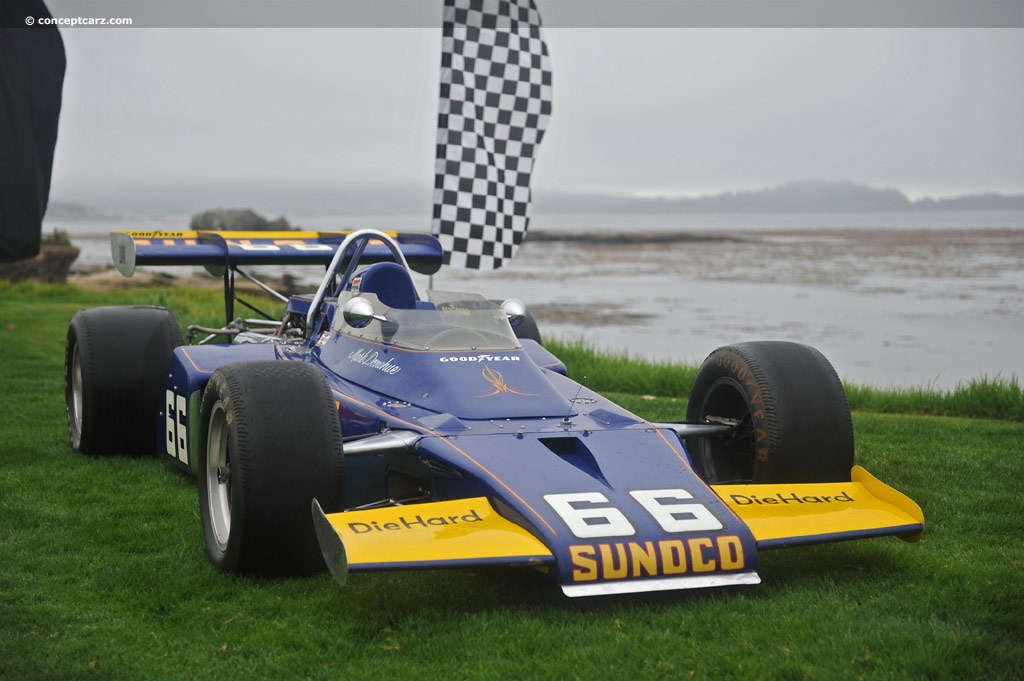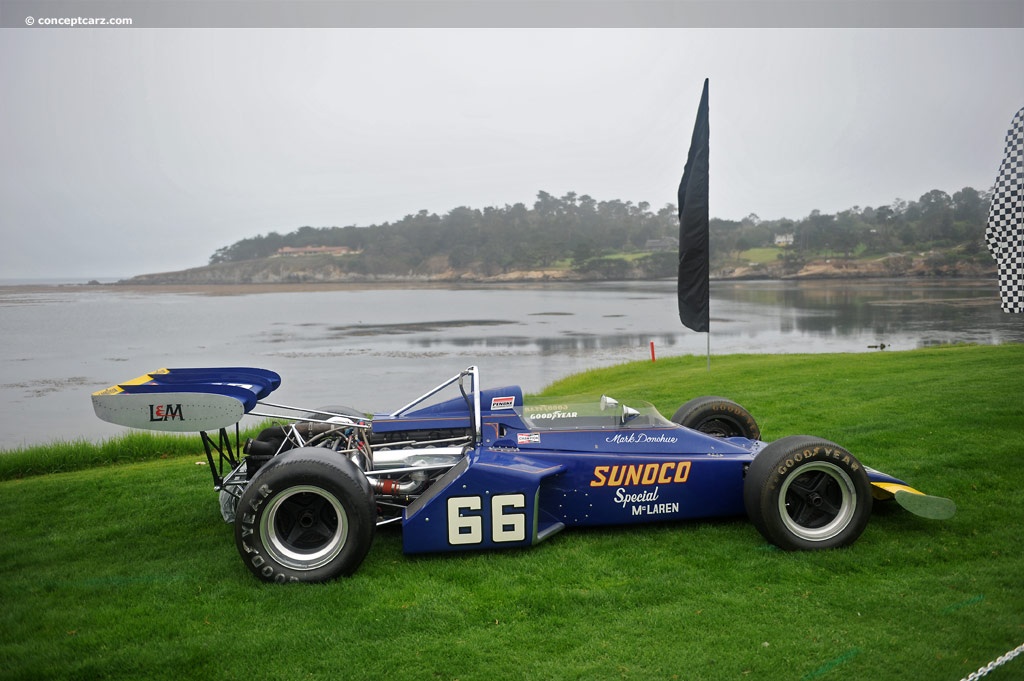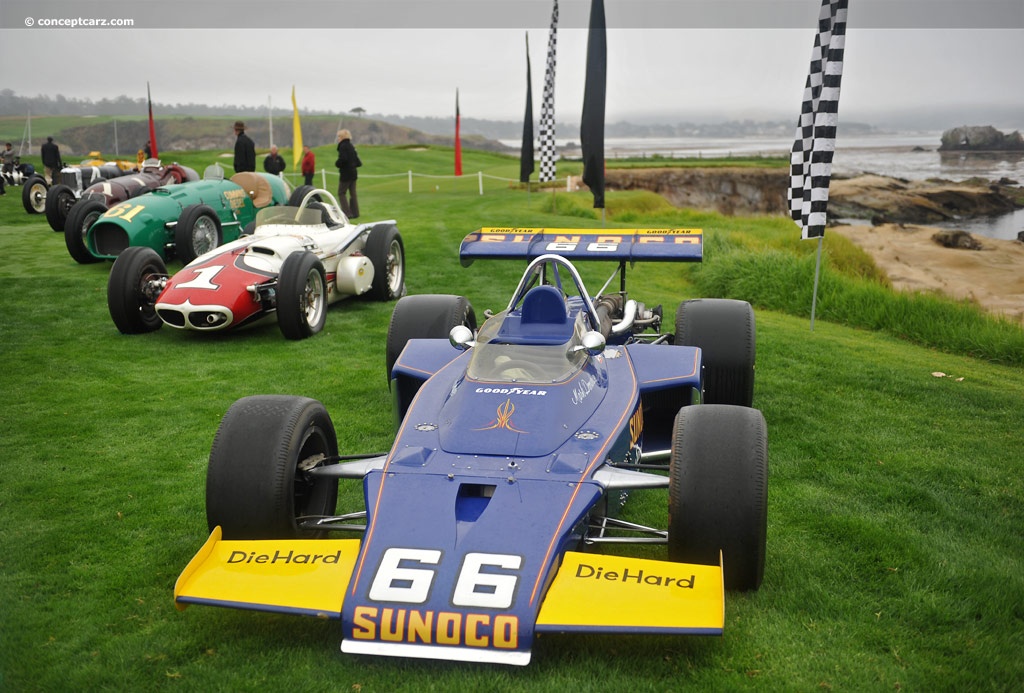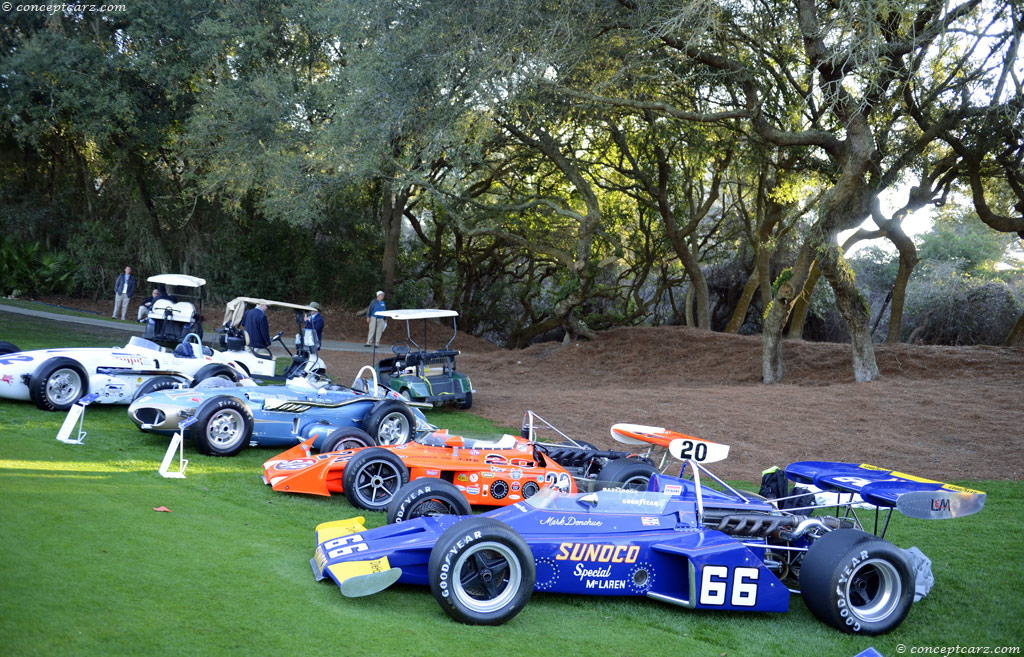The McLaren racing team, based in Colnbrook, England, built a reputation during the mid-1960s for their racing prowess and increasing success in Formula 1 and the Can-Am series in North America. They next set their sights on the Indianapolis 500. Team driver Denny Hulme was forced to retire early during the 1969 Indy while running as high as 2nd in a works Eagle, which only fueled the McLaren team to build an Indy racer. 
Racer
Chassis #: 236884
View info and historyThe McLaren team looked to their successful F1 and Cam-Am cars for inspiration, with designer Gordon Coppuck broadly basing the new 'M15' on the CanAm cars. It was given a wide aluminum monocoque chassis with the driver flanked on either side by fuel tanks. The monocoque was strengthened by three sheet-steel bulkheads designed to withstand the forces imposed by high-speed oval racing. The Offenhauser four-cylinder engine with Garrett turbocharger was positioned directly on the rear bulkhead with two a-frames connecting the monocoque tub to the bell-housing, further adding to the structural rigidity. The twin-cam 2.65-liter unit with Hilborn fuel injection produced 650 horsepower at 9,000 RPM and was backed by a Hewland LG 500 four-speed manual transaxle. Ventilated Lockheed discs provided the stopping power and steering was by a rack-and-pinion unit. The suspension setup followed a similar pattern to the M8 Can-Am cars with lower wishbones in the front with radius arms and top links. In the back was a reversed lower wishbone setup with single top links and twin radius arms. The front of the M15 was open, with a radiator resting within the square nose opening. A small windscreen wrapped around the cockpit area and continued on either side of the driver and blended in the bodywork just ahead of the mid-mounted engine. A wing was placed atop the rear portion of the engine, providing downforce at speed. Upon completion, the car was brought to Indianapolis, where it was driven at speed by Bruce McLaren and Denny Hulme, with top speed nearing 170 mph. By the start of the 1970 Indy 500, two chassis had been built, with Denny driving one and Chris Amon in the other. Both men did not make it past qualifying, with Amon requesting to be replaced due to his inexperience and struggle with the new car. The car driven by Hulme caught fire due to a loose quick-release caps, forcing Hulme to jump from the car while it was traveling at 70 mph. Peter Revson and Carl Williams assumed the driving duties. Revson was forced to retire during the race and Williams finished in ninth place. The McLaren team's debut had been tragic, with Denny nearly losing his fingers from burns, however, the M15 had proven competitive which convinced Team McLaren to try again the following year. Nothing could have prepared the team for what was about to happen, as Bruce McLaren lost his life a week after the Indy 500 debut. Despite the loss and tragedy, Hulme soldiered on and won the Can-Am title.
Racer
Chassis #: 236884
View info and historyIn preparation for the 1971 Indy 500, the car was re-designed using inspiration from the wedge-shaped Lotus 72. This setup necessitated the relocation of the radiators to either side of the cockpit in 'side-pods.' The engine continued to be an Offenhauser 2.65-liter DOHC unit with Hilborn fuel injection and Garrett turbocharger. The brakes were ventilated Lockheed disc and the transmission was a Hewland LG 500 four-speed. The chassis remained an aluminum monocoque with springs and dampers mounted in-board at the front with the rear being reversed lower wishbones, twin-trailing arms, and top links. The McLaren M16 was the team's 1971 car with the M16B being built for the 1972 season. Among the differences were the use of bolt-on rear wings, allowed for the first time at the Indy 500 in 1972 and it transformed the race, with qualifying speeds jumping from 179 to 196 mph. Along with the rear wing on the McLaren, the nose was also given two smaller wings on either side of the nose section. For the 1971 car, Coppuck added an integrated wing as part of the bodywork incorporated into the engine cover. This allowed the rear downforce to equal out the forces generated by the flat front nose.During a visit to England in 1970, along with a visit to the Lola factory, Roger Penske and his driver, Mark Donohue, visited Team McLaren. Impressed by the wedge-shaped M16, Penske acquired two cars and entered a partnership where knowledge and resources would be shared. 
Racer
Chassis #: 236884
View info and historyThe McLaren 16 drivers at the 1972 Indy 500 included Donohue, Peter Revson, and Denny Hulme. The Penske car was liveried in Sunoco colors while the car driven by Revson qualified in pole position. During the race, the Donohue-driven car quickly took the lead until being sidelined due to a gearbox failure. Hulme retired on lap 137 due to a valve issue, officially listed in 17th place. Al Unser driving a Johnny Lighting 500-sponsored Eagle won the race followed by Peter Revson in the Offenhauser-powered McLaren. Later in the season, Donohue would score two USAC victories.The revised M16B had the bolt-on rear wings and a shorter nose-cone. A total of four examples were built with Penske acquiring two. At the 1972 Indy 500, the M16B qualified at 191.408 mph. It would set an Indy Race speed record of 162.962 mph which would last for 12 years. Rick Mears driving a Team Penske car finally broke the record at 163.612 mph in 1984.The Bobby Unser car took the pole position with a speed of 1965.940 mph for four laps, breaking Peter Revon's track record of 178.696 mph from 1971, an increase of 17.244 mph, and the largest one-year track record increase in Indy history. Realizing the McLarens were unable to achieve the speeds of the new Eagle, 'turtle vs hare' approach Penske gambled on outlasting the competition. To preserve the longevity of the engine, the boost was lowered. Gary Bettenhausen led 138 laps until his car suffered ignition trouble on lap 176. Jerry Grant took the lead, but pitted for a new tire and fuel on lap 188 in teammate Bobby Unser's pit, leading to disqualification. Donohue led for the final 13 laps and finished in first place. Runner up was Al Unser Sr., who had won the race in 1970 and 1971 and had been hoping to become the first driver in history to 'three-peat' at the Indianapolis 500. 
Racer
Chassis #: 236884
View info and historyThe success enjoyed by the M16 led McLaren to create a similar example for Formula 1 which ultimately won two world titles. Further development of the M16 followed, resulting in the M16C which Johnny Rutherford qualified on pole at the Indy 500. Due to reliability issues, he would finish ninth place overall. Gary Bettenhausen's Penske entered M16C finished fifth, the best finish for McLaren that year at Indy. Bettenhausen would score one victory during the season and Rutherford won two races. In preparation for the 1974 season, the existing M16C cars were modified resulting in the M16C/D. Despite not being a new design or car, the M16C/D driven by Rutherford finished first at Indy, his first victory at the 'Brickyard' and the first of four USAC victories that year.The final evolution of the car was the M16E which had a longer wheelbase and modifications to the rear suspension.
by Daniel Vaughan | Apr 2020

Racer
Chassis #: 236884
View info and history

Racer
Chassis #: 236884
View info and history

Racer
Chassis #: 236884
View info and history

Racer
Chassis #: 236884
View info and history
by Daniel Vaughan | Apr 2020
Team McLaren has scored three Indy 500 victories, in the open-wheeled American racing series. The first win was in 1972 with Mark Donohue piloting the McLaren M16B, and Johnny Rutherford scored two victories in 1974 and 1976. The following tells the story of the 1974 race. 
Racer
Chassis #: 236884
View info and historyIt was Johnny Rutherford's second year with Team McLaren and a number of rule changes had been introduced which were aimed at reducing the overall speed of the cars. These included reducing the size of the rear wings, lowering the turbo boost by at least seven mph from the previous year, and reducing the fuel capacity by 30 gallons, down from 75 to 45 gallons. Qualifying was spread out over two consecutive Saturdays, and during Rutherford's first session, his engine blew up. Despite a very quick engine change, he was not allowed to qualify until the following Saturday. On the second qualifying day he was the second fastest, but had to start the race in 25th place. On race day itself, Rutherford had a sensational start, moving up through the field to third place by lap 12. Later in the race, he moved up a place and battled with race leader A.J Foyt. Foyt was black-flagged for oil smoke on lap 139 and then later broke the scavenger pump on his turbocharger which caused his retirement. 
Racer
Chassis #: 236884
View info and historyRutherford took the lead, which he held for 59 of the last 60 laps, only losing it briefly to Bobby Unser when he made his final pitstop. Rutherford went on to take victory at an average speed of 255 kph, lapping the entire field except for Unser who finished second.Source - McLaren

Racer
Chassis #: 236884
View info and history

Racer
Chassis #: 236884
View info and history
1972 McLaren M16B Vehicle Profiles
Recent Vehicle Additions
Related Automotive News

McLaren Racing Inducted Into Canadian Motorsports Hall Of Fame
Two-time Indy 500 winner Johnny Rutherford accepts honour on behalf of the team
TORONTO, Ont. — On February 12, McLaren Racing was inducted into the International Category of the Canadian Motorsport Hall of fame. The honour was accepted...

Five Indy 500 Winners Highlight The Silver Anniversary Amelia Concours Penske Indy Winners Class
Jacksonville, FL -- Five Team Penske Indianapolis 500-winning cars will form the core of the Silver Anniversary Amelias Penske Indy Winners class.
1972 McLaren M16BOffenhauser - Mark Donohues record setter and Team Penskes first of 18...

Emerson Fittipaldi to be honored by RRDC in Long Beach
Firestone returns as presenting sponsor for eighth consecutive year
HILLIARD, Ohio (March 2, 2017) - Two-time Formula 1 World Champion Emerson Fittipaldi, who also won a pair of Indy 500s, will be honored by the Road Racing Drivers Club...
American Honda Lends Support to RRDC Evening with Bobby Unser in Long Beach
HILLIARD, Ohio (April 6, 2015) - American Honda Motor Co., Inc., will support the RRDC Evening with Bobby Unser presented by Firestone by hosting the cocktail reception for the sixth consecutive year at the Road Racing Drivers Clubs seventh annual...

1989 Indianapolis 500: Sideways to Victory
The tension in the final moments would be so great it would take everything within Shelley Unser to keep from breaking into a shaking fit. Two laps from the end of the race, traffic would dramatically slow Al Unser Jr.s pace allowing Emerson Fittipaldi...































